Python vs. Java: What’s the Difference?
Python vs. Java has been ongoing in the programming world for quite some time. These two languages have established themselves as excellent choices and have garnered immense popularity over the years. With solid and well-established communities backing them, developers can rely on the abundant support available to enhance their expertise and abilities.
For a considerable period, Java held the top position in popularity rankings. However, in recent years, Python has taken the lead and surpassed Java in widespread adoption. As a result, many individuals find themselves drawn to the comparison of Java versus Python, seeking to determine which language best aligns with their specific requirements.
Python, created by Guido van Rossum in 1991, is a high-level, interpreted, and general-purpose language. It prioritizes code readability, enabling programmers to express logic concisely with fewer lines of code. Initially developed in 1995 and now owned by Oracle, Java is a high-level, compiled programming language. It follows a class-based, object-oriented approach and is a versatile general-purpose programming tool.
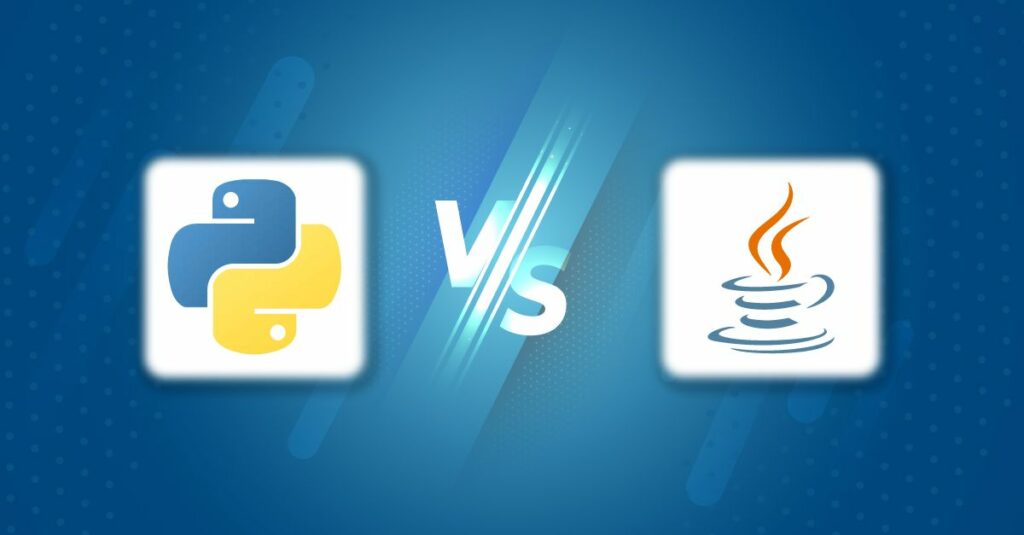
This blog will explore the question, “What is the difference between Java and Python?”. We explore the contrasting aspects of these widely-used programming languages. We will cover various features of these two languages, making them so different yet equally practical and popular.
Comparing these languages lets you understand their characteristics, aiding your decision to choose a language that fits your goals with confidence. Understanding the similarities and differences between Java and Python can guide you toward the most appropriate language.
Comparing Python and Java for Different Technology Needs
Both high-level languages support Object Oriented Programming and are general-purpose. However, a clear contrast in features and application scenarios can be seen when comparing Java vs Python.
Python’s simplicity and readability make it an excellent option for web development, prototyping, creating minimum viable products (MVPs), and smaller projects. Python is also capable of handling large-scale applications. This is indicated in using Python-based backend services in major high-traffic platforms like Instagram, YouTube, and Dropbox. These successful implementations demonstrate Python’s ability to scale and perform reliably in demanding environments.
Java’s performance, scalability, and extensive libraries make it an excellent choice for large-scale web projects and mission-critical applications. It is widely used for building enterprise-level web applications.
Python vs. Java: Key Differences
This blog will focus on the key Python and Java differences. By exploring various aspects, we aim to comprehensively understand their design philosophies and purposes.
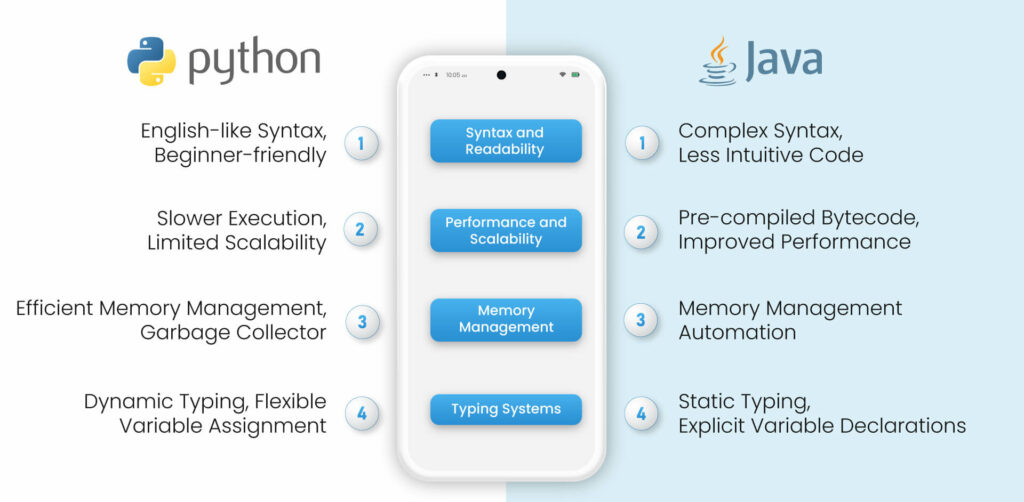
-
Syntax and Readability
Python’s syntax is closer to plain English, making it faster to learn and progressively simpler to test your code. It is also highly readable, eliminates the need for explicit data type declarations, and utilizes indentation to define code blocks.
On the other hand, Java relies on braces to define code blocks, requires semicolons, and implements static typing. More effort and time are needed for the developers to keep the code readable in Java.
-
Performance and Scalability
Within the programming community, a frequent topic of debate revolves around the question: ‘Is Python faster than Java?’. The performance difference between Java and Python is significant. Java compiles code in advance and distributes bytecode, resulting in significant performance advantages. Python typically compiles code at runtime, which can impact its execution speed.
Java’s bytecode is executed by Java Virtual Machine (JVM), and the compilation done in advance allows various performance optimizations. This results in generally faster execution speeds compared to interpreted languages like Python.
Python is less scalable in performance and execution speed than Java because it is an interpreted language. Also, a much more robust support for multithreading is another advantage that Java has against Python. Python’s GIL (Global Interpreter Lock) prevents the Python interpreter from performing multitasking. The GIL allows only a single thread to run at a time.
-
Memory Management
When your application no longer references an object in Java, the garbage collector deletes it. This frees up the associated memory. As the number of objects in your Java application increases, so does the memory usage.
Python employs a reference counting mechanism to manage objects. Here the memory manager tracks the number of references to each object within a program. When an object is no longer used, the garbage collector automatically releases its associated memory. This ensures efficient memory management by promptly freeing resources when no longer needed.
-
Typing Systems
Both languages are object-oriented, so is Python similar to Java regarding coding conventions?
They are not; the coding style difference between Python and Java is easily recognizable. Java uses static typing, while Python is dynamically typed. This is one of the most significant differences and dramatically affects how you design, code, and debug your programs.
For example, variables can be defined in the following way in Python.
val_two, val_ten = 2, 10
greeting_list = [“Hello”, “World!”]
goodbye = “Goodbye!”
While the same variables can be defined in Java as follows
public class Main {
public static void main(String[] args) {
int valTwo = 2;
int valTen = 10;
String[] greeting list = {“Hello”, “World!” };
String goodbye = “Goodbye!”;
}
}
In Java, the data types need to be declared explicitly. Static typing catches type errors at compile time while enforcing a strict discipline that many developers appreciate. Also, notice the lower camel case instead of Python’s snake case for naming variables.
Application Areas for Businesses
Both languages showcase high versatility when discussing Java vs. Python in business application implementations. Their widespread usage across diverse fields is a significant factor driving their popularity. Their extensive application in various domains contributes significantly to their wide acceptance.
Java for web applications, Android development and e-commerce applications
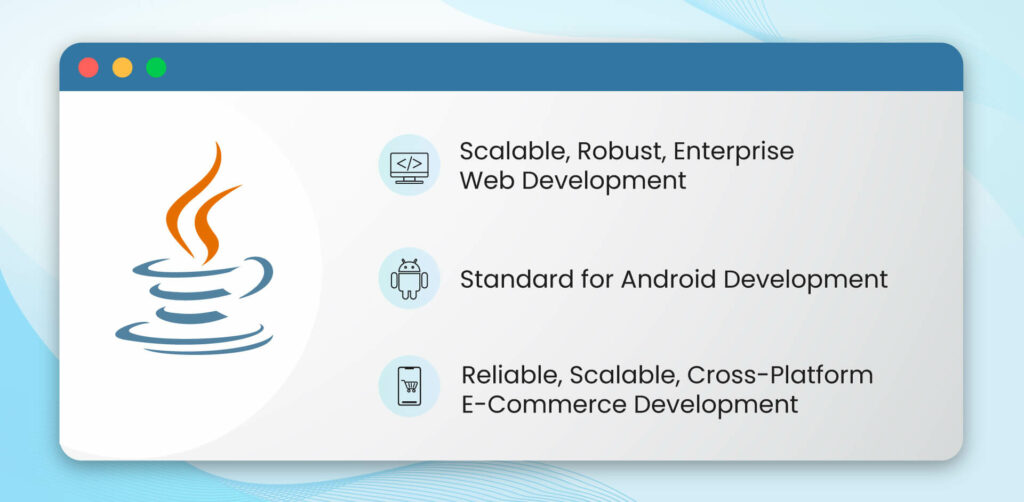
Java has been popular for web development for a long time due to its scalability and robustness. These traits make it suitable for enterprise-grade web applications.
Java (or Kotlin) is the standard language for Android development. The official Android SDK and development tools are also primarily Java-based. Java is widely used for Android app development, offering seamless integration with the Android platform and a rich library ecosystem. It benefits from a strong community of developers, providing extensive resources and support.
Java is popular due to its reliability, scalability, and cross-platform compatibility. Its specific features, integration capabilities, and robust developer community contribute to its general recognition. These factors make it a preferred option for developing robust and scalable e-commerce applications.
Python for web development, data analysis, automation and machine learning
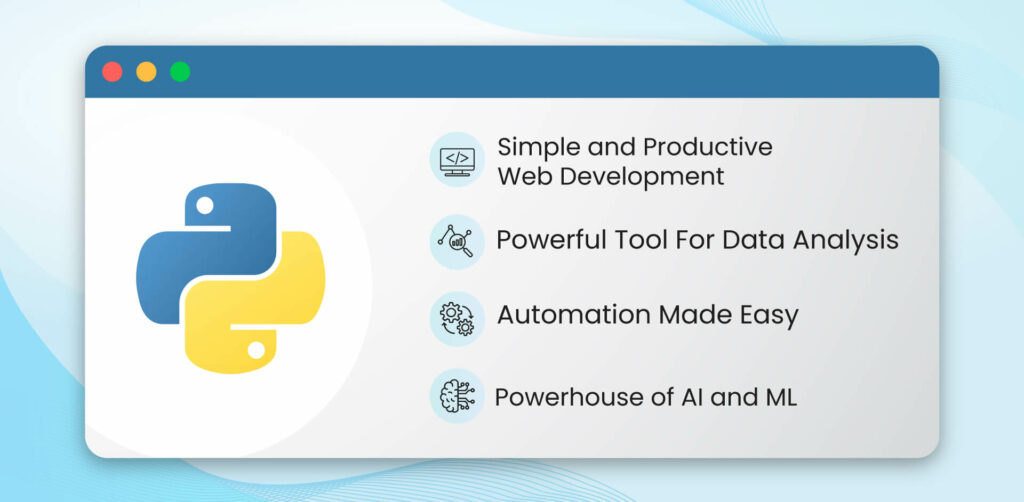
Python’s use in web development proliferates due to its focus on simplicity and productivity. It is an excellent choice for rapid web development. It also offers lightweight solutions suitable for smaller projects or microservices.
Python is extensively used in the field of data analysis and scientific computing. It provides powerful tools for data manipulation, analysis, and visualization. It is a preferred choice for scientific and number-crunching applications.
Its simplicity and readability make it an excellent choice for writing scripts to automate repetitive tasks. It has many web, testing, network, and infrastructure automation libraries. This makes it suitable for handling various automation tasks across various domains.
Python dominates the AI and machine learning domain due to its robust ecosystem and community support. It is the preferred language for AI and machine learning. It offers powerful libraries which provide extensive functionality for building and training machine learning models.
Framework and Libraries
Both languages offer frameworks and libraries that compete across various domains in the Java versus Python debate. Java and Python provide an extensive selection of frameworks and libraries that engage in competition across multiple domains.
Comparing popular Java and Python frameworks for businesses
Java’s Spring is a popular comprehensive framework for building enterprise-level Java applications. It provides features like dependency injection, transaction management, and support for building RESTful APIs. Spring Boot, a module of the Spring Framework, simplifies application setup and configuration.
Hibernate is another popular framework that simplifies database access in Java applications as it is an Object-Relational Mapping (ORM) framework. Its flexibility has contributed to its widespread adoption in the Java development community.
Python’s Django, which could be considered a direct rival of Spring, is a high-level web framework. It follows the model-view-controller (MVC) architectural pattern and can be used to build RESTful APIs. It provides robust features for rapid development, including an ORM, authentication, and built-in administration interface.
In addition to Django, businesses leverage frameworks like Flask, Pyramid, and the newer FastAPI to tap into the Python ecosystem’s benefits. These frameworks offer diverse options for businesses to capitalize on Python’s capabilities.
The influence of available libraries and tools on development efficiency
Application development presents various common challenges that developers frequently encounter. Robust tools and libraries can accelerate development by solving these most common challenges.
Developers can leverage existing code, libraries, and frameworks to speed up the implementation of various functionalities. It also boosts code reusability so that developers can save time and effort. This, in turn, ensures consistency and reduces the likelihood of introducing errors.
Employing the correct libraries and tools simplifies complex tasks and automates repetitive processes, boosting developer productivity. For example, libraries for data processing provide pre-built functionalities and APIs that developers can leverage. This reduces the need for manual implementation. Also, it allows developers to focus on higher-level logic and business requirements, improving overall productivity.
Using appropriate libraries and tools enables developers to follow established standards, encompassing industry best practices, coding conventions, and design patterns. By embracing these resources, there is a significant improvement in code readability, maintainability, and collaboration within development teams. It also improves coding efficiency, leading to more robust and reliable software solutions.
Integration and Interoperability
Integration and interoperability are vital aspects of programming languages, allowing smooth interaction and compatibility with different components and systems. They facilitate seamless communication and collaboration, enhancing the overall functionality and versatility of the language.
Java’s compatibility with existing systems and technologies
Designed to be platform-independent, Java applications can run on various operating systems, hardware architectures, and devices without requiring much modification. Java achieves its compatibility primarily through utilizing the Java Virtual Machine (JVM). JVM is an in-between component connecting the Java code with the underlying operating system.
Java supports various communication protocols and data exchange formats, making establishing interoperability with other systems easier. The extensive library ecosystem offers numerous APIs and frameworks. These elements facilitate integration with existing systems, web services, databases, messaging systems, and more.
Businesses can use Java’s compatibility with existing systems to maximize their investments in legacy systems. Integrating Java-based solutions seamlessly into their existing IT infrastructure is an effective means of saving resources.
Python’s ease of integration with other programming languages and tools
Python is known for its easy integration with other programming languages and tools. This significantly contributes to its versatility and popularity. Python provides several mechanisms that facilitate seamless integration with various languages and tools. This allows developers to utilize preexisting code and libraries from various ecosystems, effectively leveraging their benefits.
Python provides extensive support for C/C++ integration. Developers can easily incorporate existing C/C++ code into Python programs using modules such as types, CFFI, or pybind11. To maximize their potential, Python applications can effectively utilize the extensive range of C/C++ ecosystem libraries and resources. Its support for message queues and data serialization formats such as JSON and XML significantly expands its integration capabilities.
Python applications offer cross-platform compatibility. These applications are runnable on diverse operating systems such as Windows, macOS, and Linux, as well as various embedded systems. This wide-ranging compatibility ensures ease of deployment and broad accessibility for Python applications.
Developer Availability and Costs
In recent years, Python has experienced rapid growth and widespread adoption, especially in data-related domains. On the other hand, Java maintains a strong presence in enterprise and Android app development.
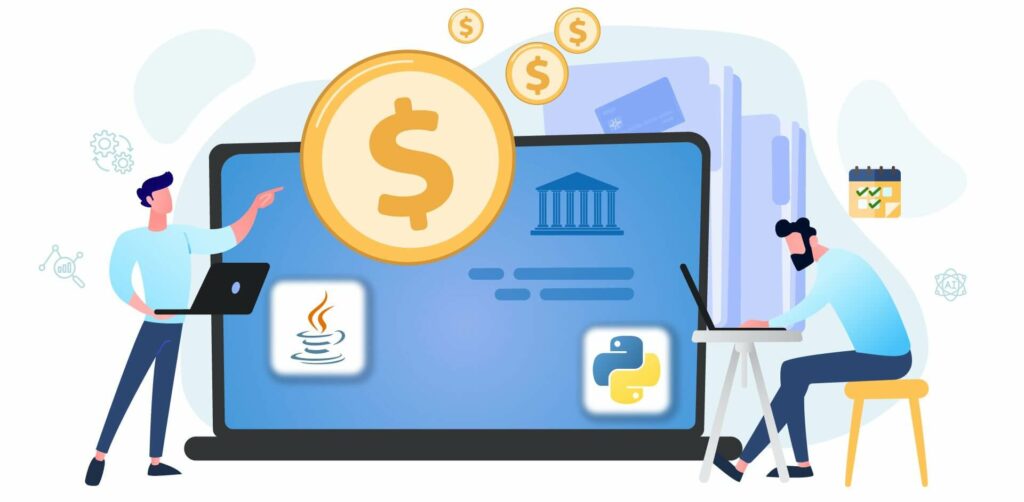
Comparing the market for Python and Java developers
Python has become increasingly popular in the developer market due to its beginner-friendly syntax and its vast ecosystem of libraries and frameworks tailored for data science and machine learning. Python developers are in high demand across web development, data analysis, AI, and automation industries. On the other hand, Java remains a dominant language for enterprise applications, Android development, and server-side programming. While its syntax may be more verbose, Java offers a mature ecosystem and job market, with opportunities in fields like enterprise software development and financial services.
Hiring Costs and the Impact on project budgets
The rates for Python and Java developers vary based on their skills and experience. Experienced Java developers may expect higher salaries due to the complexity of enterprise projects. Assessing project requirements is crucial to determine the required skills and experience. Python’s simplicity enables faster development for detailed projects, while Java’s verbose syntax and thorough testing may require more time, increasing labor costs. Development time directly impacts the budget.
Conclusion
The answer of what to choose depends on the specific requirements of the project when deciding between Java and Python. Various other factors need to be considered as well. Let’s try to understand them further ahead.
Understanding the differences between Python and Java for informed decision-making
When choosing between Python and Java, it’s crucial to understand their key differences. Python’s growth stems from its simplicity, readability, and expressive syntax, making it popular for web development, data analysis, machine learning, and scripting. On the other hand, Java is widely used in enterprise development, server-side applications, Android app development, and large-scale systems.
Python’s beginner-friendly syntax and ease of learning make it ideal for rapid prototyping. At the same time, Java has a steeper learning curve, requiring knowledge of object-oriented programming and a more complex syntax.
Regarding performance, Python’s interpreted nature may result in slightly slower execution than Java’s compiled nature. Java’s Just-In-Time (JIT) compilation and optimized virtual machine contribute to faster performance.
Both languages have rich ecosystems with libraries and frameworks. Python offers Django for web development and NumPy and Pandas for data analysis, while Java has a mature ecosystem tailored to enterprise and Android app development.
When deciding between Python and Java, consider factors like application domain, performance, ecosystem, learning curve, community, and the job market. Both languages have unique strengths and are suitable for different requirements. Assess your project’s specific needs to make an informed decision.
Unlock the combined potential of Java and Python programming with our team of skilled developers for hire. Hire Java developers and Hire Python developers for a flexible trial period and advance your projects.
Frequently Asked Questions
Both languages can co-exist without the Java vs. Python debate for an application’s development language choice. Leveraging both languages in collaboration can harness the unique strengths and capabilities of each. You can have Python and Java components that work together in an application.
Employ interprocess communication mechanisms such as sockets, message queues, or web services to establish communication between separate processes. Develop a Python or Java web service/API for consumption by another language, enabling distributed system construction with communication via protocols like HTTP.
Choosing the right programming language for application development is crucial for a business, aligning with long-term goals. Factors like performance, scalability, domain-specific needs, budget, team expertise, existing codebase, infrastructure, development speed, compatibility, and long-term maintenance influence the choice of Python, Java, or both.
Python’s standard library and ecosystem offer diverse security modules, cryptography, and network security. The active community swiftly addresses security concerns with timely patches. Java prioritizes security with built-in features like bytecode verification, sandboxing, and a security manager. Static typing and strong type-checking mitigate common programming errors. Python requires extra diligence for security due to its dynamic nature, necessitating secure coding practices and regular updates for robust protection in business projects.




